I used to fear working on the brake systems of my vehicles because of how vital they are in avoiding becoming one with other cars on the road. If you don’t have knowledge on your side along with some mechanical aptitude and proper tooling, that fear is justified.
It’s not hard to arm yourself with those things if you decide to take the plunge, and this write up will help give you the knowledge portion.
Areas of Focus
For Inspection and Maintenance:
- Pads and Shoes
- Rotors (discs) and Drums
- Brake Lines
- Brake Fluid Level
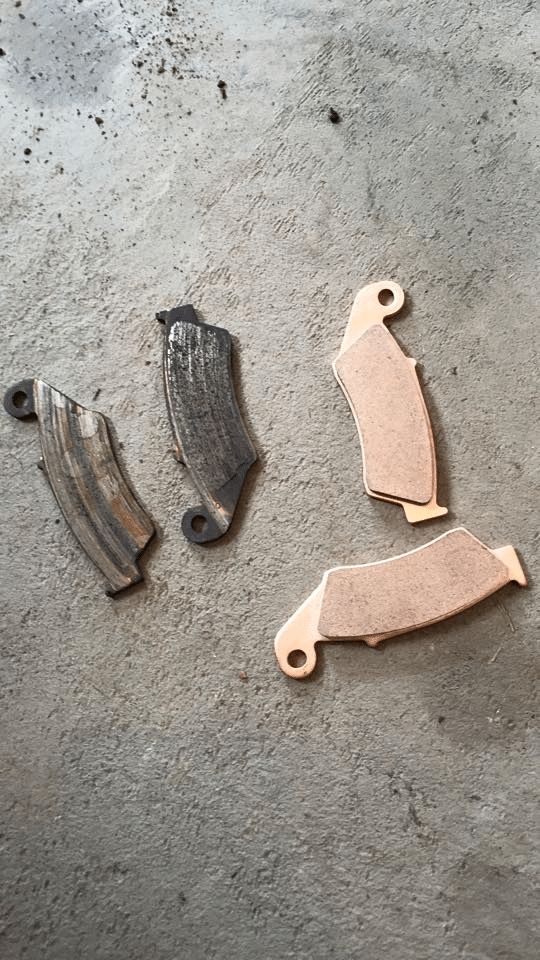
Pads and Shoes
Inspection and regular maintenance is paramount when it comes to catching problems early. The brake pads on the left in the photo above came off a dirt bike I purchased a few years ago. The pads on the right are brand new in comparison.
While test driving the bike, nothing seemed to hint that the front brake pads were in such poor condition because the braking power was normal. In fact, it braking was better than normal, which can sometimes be an indication of a problem.
Once all the friction material is worn away on brake pads the metal backing plate of the pad pressing on the disc grips quite well. This yields better stopping power temporarily, until the metal starts to suffer more heat damage and degrade to the point it fails spectacularly.
It also tends to destroy the disc or rotor because the pad’s backing material digs into them better than the pad’s friction material does.
Signs of Trouble To Look For On Brake Pads
Uneven Wear: Pads should wear fairly evenly if they aren’t hanging up on the slider pins. If they aren’t check to make sure the pins aren’t bent or damaged in any way.
Oil and Dirt Contamination: In the picture above you’ll notice how the material left on the pads is dark almost like it’s been burnt. It’s actually fork oil that had previously leaked out, ran down the chrome and wound up contaminating the brake pads.
- You never want oil of any kind around your brakes for obvious reasons. This burnt fork oil helped break down the pads’ friction material and accelerate wear.
- If you see this happening, first repair the fork seal leak and then replace the brake pads otherwise it’ll keep contaminating them.
Glazing: There are signs of glazing on the friction material left too. Glazed portions look shiny and smeared. It’s caused by high heat and makes braking less effective and squealing or grinding noise at times.
Signs of High Heat: When there’s glazing you’ll usually also find a rainbow or dark blue/purple condition cropping up on the pads and discs. This can be a sign of a seized brake pad on a pin or even caliper piston.
- Another sign of high heat would be cracks developing in the friction material or large chunks missing.
When In Doubt: Replace Brake Pads
As a rule, I replace the brake pads on all used bikes I buy regardless of condition, so I can check them carefully and start fresh with the maintenance intervals. They’re not very expensive and peace of mind is priceless.
I’m glad I did in the case mentioned above especially because there were no warning signs anything was amiss. No squealing, pulsating or any other typical warning signs I watch for. I replaced the pads just in time before catastrophic damage was done to the rotor, thankfully.
Brake rotors are wickedly expensive so take the time to inspect the pads at least once a season or more if you’re riding extensively or off road.
Caution
Brake dust is hazardous to your health!
- Whenever working around brakes use brake clean to wash away the dust and dirt.
- Wear nitrile gloves and avoid breathing in anything you clean off friction surfaces.
- Even though newer brake linings aren’t asbestos as they used to be, brake dust of any kind isn’t good.
- If there’s an extreme amount of debris and dirt to remove use water and then brake clean to remove any moisture left behind.
Pad Replacement
YouTuber smallengineshop shows how this is done in this video on his Kawasaki KLR650. The procedure will be different from bike to bike and you should definitely buy a repair manual for your specific model to reference before starting to work on your motorcycle. There are many different designs of brake calipers in use today that come apart in totally different ways.
He mentions 0.040” as the minimum thickness for the pads on his bike and that’s a good standard number to gauge yours by. The other general guideline is that the friction material should be thicker than the backing plate. In the end it’s best just to follow your bike manufacturer’s specification.
Replacing the brake pads is easy when you have them out anyway for inspection.
Additional valuable tips:
- Smooth/polish the pins that the pads slide on with fine steel wool, especially if there is any kind of buildup on them. Some people also put graphite dry lube on them, but just keeping them smooth and clean is best.
- Put a slight chamfer on the leading and trailing edges of the pad backing plate where they slide on the caliper frame.
- While the pads are out for inspection you can take some sandpaper to the friction material just to rough the surface up to help fight glazing and remove any unwanted debris embedded in it. Don’t get carried away and remove material, just scratch up the surface evenly
- Follow manufacturer procedures for brake pad bedding. Usually this involves avoiding emergency applications for 300 miles depending on the kind of pads. EBC Brakes has a great write up on it here:
- When you replace brake pads bleed some of the brake fluid out of the line(s). More on how to do that later.
These measures help ensure easy application and retraction of the brake pads yielding proper brake life on your motorcycle.
Drum Brakes
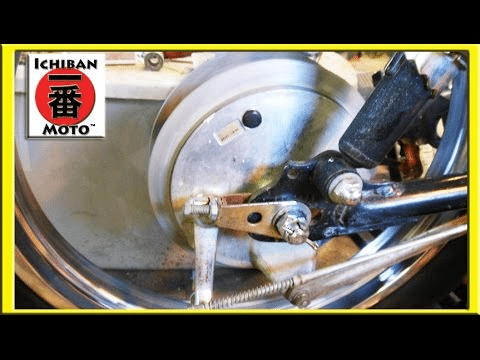
Photo YouTube’s Ichiban Moto
Becoming more rare (thankfully), but still around on many bikes – are drum brakes.
Drum brakes use cables or rods to activate them instead of hydraulics, and those need to be checked for stretch and damage according to manufacturer’s specifications. Poor braking power could be caused by stretched cables or rods.
The “pads” used in drum brakes are called shoes, not pads, if you want to use correct nomenclature.
The same inspection criteria applies to both brake shoes and drums, but the method differs.
- Some have a small inspection plug on the cover to remove allowing inspection of the thickness of friction material remaining on the shoes.
- Others have an external gauge to reference. The gauge is more convenient because all you do is hold down the pedal and make sure the arrow is still in the usable range.
Adjusting them is fairly straightforward. Turn in or out the adjuster nut on the rod coming from the brake pedal to set the brake activation point. Get the rear wheel off the ground and turn the adjuster nut in until the brake comes on fully when you push the pedal down.
Make sure the brake doesn’t drag when the pedal is released.
Replacing the shoes involves removing the rear wheel from the bike. Not rocket science either, but you’ll have to set the tension on the chain when you’re finished as well.
Importance of Proper Drum Maintenance
Here’s a video from YouTube’s Brandiland as she changes the brake shoes on her dirt bike drum brake.
It gives pretty good guidance of how it’s done, but I would stress how important it is to use Brake Clean instead of just a dry shop towel on the drum and hub assembly to avoid inhaling brake dust. Maybe she used it but didn’t include that footage in the video?
She says the dirt found inside is “regular” but it’s not. Her brake is contaminated with dirt or mud and needs to be cleaned out to avoid accelerated wear.
I also spotted some deep scratches on the friction material of the brake shoes caused by the dirt which she doesn’t mention. It’s good she chose to replace those shoes.
I would say the seal on the brake housing (if there is one) should also have been changed to stop more dirt from getting in. With dirt bikes, contamination is almost unavoidable due to the sheer amount of mud they ride in.
It’s also a good idea to put axle grease on the axle bolt when reinstalling it.
Brake Rotors and Drums
Solid Rotors
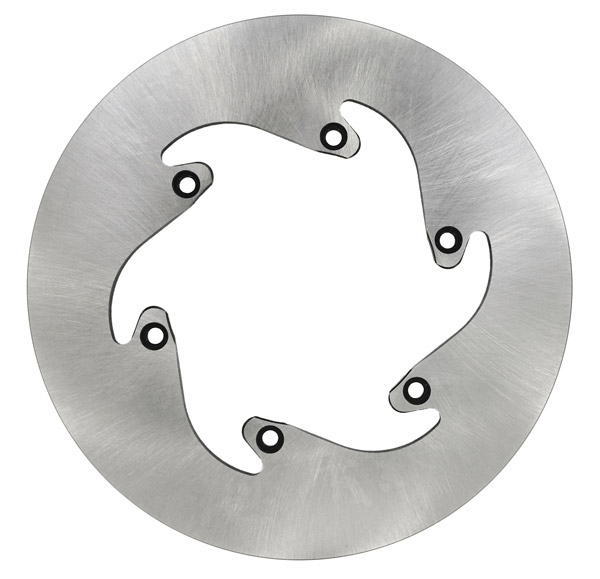
Photo via EBCBrakes
Solid rotors used on bikes are mostly maintenance free, but need to be inspected for damage and wear. You can also clean them with disc cleaner specific solution or isopropyl alcohol.
Some people take Scotch Brite pads on the wear surface to remove any embedded brake pad material too.
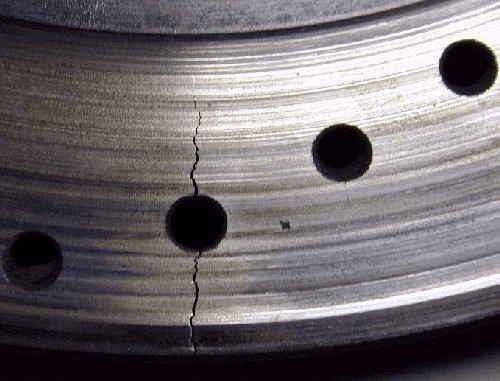
Photo from Quora.com
There is a minimum thickness specification for rotors (discs) in order to remain in service. Leaving them in service past this point runs the risk of them cracking and failing catastrophically.
Rotors, like brake pads can show signs of glazing, cracking, heat damage and deep grooves caused by contamination of the brake pads. Any of these will necessitate replacement of the rotors.
If you get grooves worn deeper than 0.5mm in either side of the rotor, replace it or them. You can have the rotors machined flat again but not if doing so thins it past the minimum thickness allowable.
Don’t replace individual pads or rotors from a set of multiples. If you need to replace a single component on one wheel (like one pad out of 4, or 1 rotor of 2) you should change all the same kind of neighbouring parts to maintain a balanced braking system.
Floating Rotors
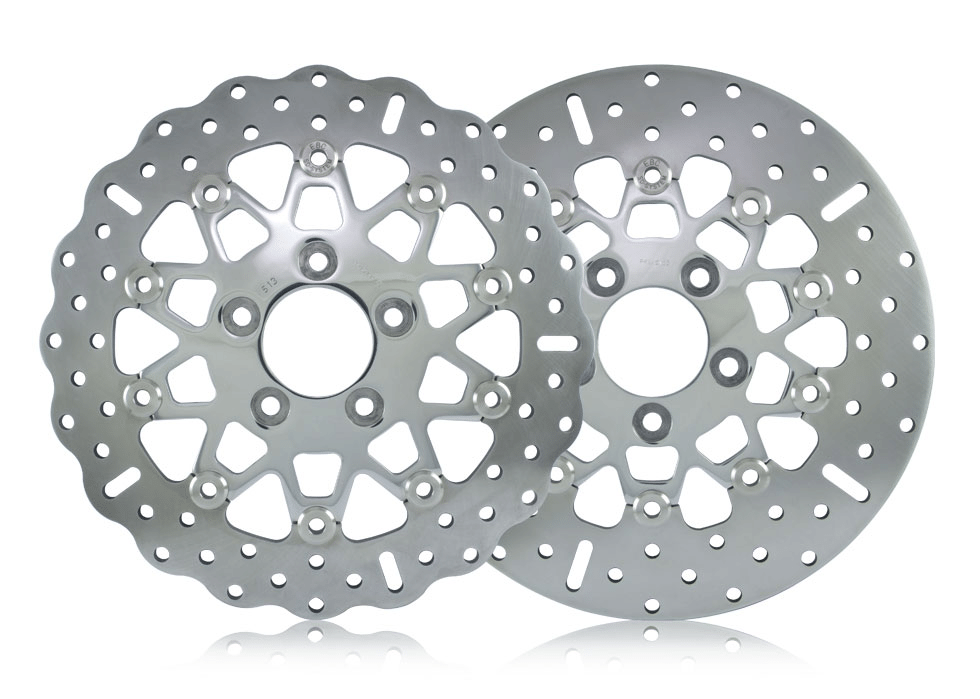
Photo via EBCBrakes
The photo above shows a couple of types of floating rotors.
The identifying characteristic is the round rivets connecting the inner carrier and outer friction surface area (blade) where the pads grip. The rivets are the only bond holding the two halves together and you can see a small gap between them.
- The rivets, aka buttons or bobbins, allow different types of metal to be used which helps deal with heat expansion and dissipation.
- The inner metal carrier is usually aluminum and the outer blade steel.
This design compensates for some movement of the outer ring when braking occurs. That flexibility gives smoother and more efficient braking by keeping the pads in better contact with the disc. On semi floating discs this movement is less pronounced while on full floating ones there’s more movement or float.
Most manufacturers equip semi floating discs these days while full floating ones are generally only found on racing motorcycles.
Testing and Maintaining the Rotors
Over time those rivets can seize up due to buildup of debris and brake lining material which causes vibration to be felt by the rider. You’ll find tapping on the rotors with a rubber mallet will produce a buzzing sound from rotors that are still loose and doing their job. That will diminish as they seize up and conversely ring more solid.
There are many videos on youtube of people doing various things to free them up again involving brake clean and drills. Some even use penetrating oil – DO NOT use any oil around brakes.
If you want to clean out the rivets and service the rotor, remove the wheel from the bike and use compressed air and brake clean, disc cleaner or isopropyl alcohol to do it. While you’re at it take Scotch Brite pads to the blade surface to clean it up too.
This is a useful piece of maintenance to do, but really, if your rotors are causing vibration they’re most likely warped due to high heat and should just be replaced along with the pads.
Drums should be inspected for damage, cleaned with steel wool and brake clean then measured on the inner diameter to determine usability. You’ll have to check manufacturer’s specifications for the maximum allowable inner diameter, but if you find uneven wear just replace the drum.
Brake Lines
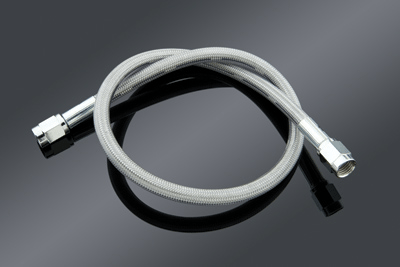
Photo via JPCycles
Whether you have steel braided lines or rubber coated you should take time to inspect them for loose fittings, bulges, cuts and leaks at the crimps. Don’t take chances with them. Replace the lines if you find anything unusual.
Brake Fluid
If you replace a brake line you’re obliged to drain and replace the brake fluid too. The purpose of bleeding is to remove old fluid or air pockets in the reservoir, lines and calipers.
Be Aware
Some people check the level in the reservoir and then choose to overfill them thinking it should be full to the top. More is not better when it comes to brake fluid. There needs to be some room in the reservoir for expanding fluid to retreat to during heavy braking. Thermal expansion of the fluid can become a real concern in extreme cases.
If the expanding fluid can’t move up the lines into the space in the reservoir it will instead start to apply the brakes by pressing against the piston(s) in the calipers.
Getting it Done
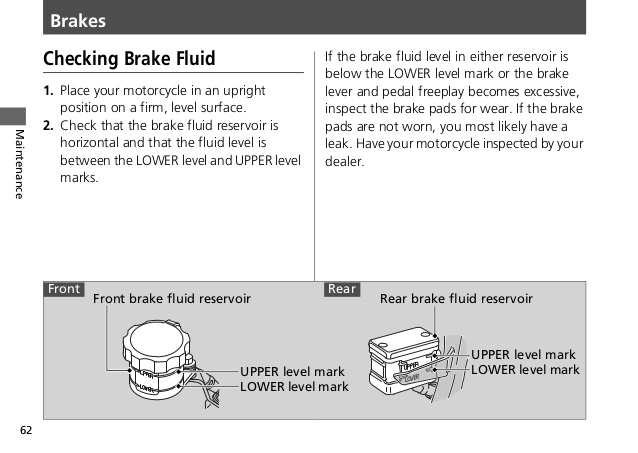
Just as it says on this page from a Honda CBR600RR maintenance manual, maintain the fluid about halfway between the upper and lower marks. When you replace the fluid fill to the halfway point, bleed the lines and then top up to halfway again, and replace the cover.
You’ll need a partner to avoid a lot of mucking about when it comes to bleeding and flushing. You can do it by yourself if you buy a vacuum bleeder tool, but it’s not necessary if you have friends and family members to spend quality time with in the garage.
Brake fluid damages paint and clearcoat. Take care not to get it anywhere on your bike without immediately removing it.
This YouTube video from Sum4Seb shows how to drain, flush and fill the front brake circuit using a helper. It appears he recruited his daughter or wife to help out with the job. Bonding over brakes. Doesn’t that just tug at your heartstrings and bring a tear to your eye?
Use caution with the bleeder screw on calipers which don’t need to be hamfisted or closed super tight. They will easily sheer off if you use gorilla level strength on them.
If you have twin caliper brakes in the front you’ll need to flush and bleed each circuit separately.
Choosing the Correct Brake Fluid

When replacing brake fluid it’s critical to use the correct type of brake fluid and follow the maintenance schedule. Typically this is done every two years and the correct DOT brake fluid type will be stamped in the reservoir cover.
Brake fluid absorbs moisture over time especially when left exposed to air. That moisture can lower the boiling point of the fluid which is a real concern when things heat up.
As mentioned in the video, brake fluid is nearly free of colour when in good condition. If yours appears dark or murky there’s a good chance it’s been contaminated or burnt because of heat and should be replaced.
Usually it’s DOT 4 or 5 in motorcycles. DO NOT mix any different fluid with silicone based DOT 5 fluid. They won’t mix well and you’ll have big issues. There are non-silicone based DOT 5 brake fluids produced now on the market just to complicate things.
The best idea is to pay close attention the the label and always use the same fluid.
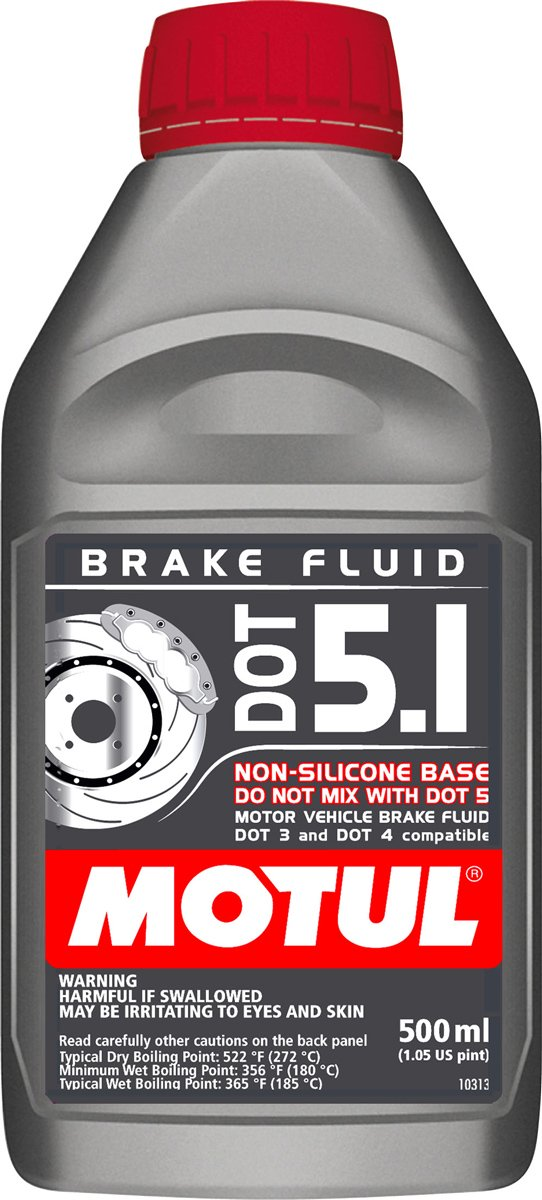
Final Thoughts
Motorcycle brake maintenance is nothing to shy away from as it turns out. You may need to purchase some torx or allen sockets in order to do the work, but those aren’t exotic by any stretch.
Most important, read and follow the proper procedure in the service manual to do it correctly. YouTube is a great reference, but not completely reliable.
The personal satisfaction gained in doing your own work will put a smile on your face and grow your confidence to tackle bigger projects.
Saving some money never hurts either. Take the money saved on labour and invest it in higher performance parts instead!

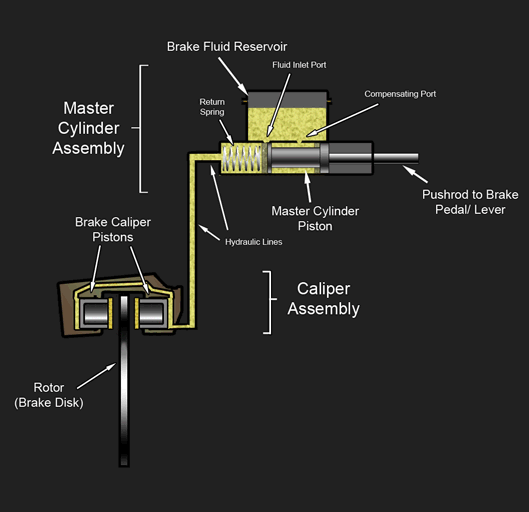

Good tips. Maintaining your own brakes on motorcycle is AMAZINGLY simple if you have the the right tools, cleaners and patience. Like an oil change, it’s something everyone can do if they try without worry. YouTube is a new moto mechanic’s best friend if in doubt.
Great article. These are simple tips and anyone can do it with ease. Make sure to protect paint before brake bleeding.
Thank you both for the feedback.
Absolutely it’s a fairly easy but of maintenance doing motorcycle brakes if you’re prepared.